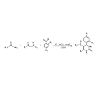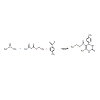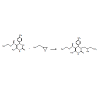Research Article
The Synthesis of Tetrapyrimidines and their Carboxylic Derivatives and the Application of Antimicrobial Properties
AR Sujayev*, EN Garibov, NM Nazarov
Laboratory of Theoretical Bases of Synthesis and Action Mechanism of Additives, Institute of Chemistry of Additives,Azerbaijan National Academy of Sciences, 1029, Baku, Azerbaijan, Russia
Corresponding author: AR Sujayev, Laboratory of Theoretical Bases of Synthesis and Action Mechanism of Additives,Institute of Chemistry of Additives, Azerbaijan National Academy of Sciences,1029, Baku, Azerbaijan, Russia, Tel:(+994503978801); E-mail: s.afsun@mail.ru
Citation: Sujayev AR , Garibov EN, Nazarov NM. The Synthesis of Tetrapyrimidines and Their Carboxylic Derivatives and the Application of AntimicrobialProperties. J Chem Applied Biochem. 2015;2(1): 113.
Copyright © 2015 AR Sujayev et al. This is an open access article distributed under the Creative Commons Attribution License, which permits unrestricted use, distribution, and reproduction in any medium, provided the original work is properly cited.
Submission: 03/09/2015; Accepted: 26/09/2015; Published: 03/10/2015
Abstract
The article was dedicated to the research directed to the synthesis, transformations and studies of the biologically active substances havingmultidisciplinary scientific and technical application areas. For the first time, synthesized and functional properties of tetrapyrimidines-derivatives of cyclicthiocarbamides, which are a new generation of multifunctional compounds and their carboxylic-based compounds were examined, the antimicrobialproperties of these compounds were studied with the laboratory experiments and was approved that they have active physiologically active compoundscompared to their analogues.
Keywords: Cyclic thiocarbamides; Tetrapyrimidines; Carboxylic derivatives; Antimicrobial properties; Gram-positive microorganisms; Bacteria; Meat-andpeptoneagar etc.
Introduction
The need for the new researches for raising the efficiency ofin the development of the petrochemical and medical industry isnoticeable. Especially, there is a specific fundamental and applicableissue in science that the approach on a scientific direction in theirsolution does not justify itself and is not achieved satisfactory resultsfor many years. The need for a complex scientific approach arisesfor such issues and the most successful scientific results of recentyears are found in the research of the intersection of science withthe multidisciplinary approach. From this point of view, as a resultof the most recent studies conducted in the Institute of Chemistryof Additives of the Azerbaijan National Academy of Sciences, it wasdetermined that, biocide additives synthesized at the institute shows biological (physiological) activity in other areas too, in additionto protect the oil products from the microbiological damage. Forinstance, amino ethanol and some derivatives of amino alcoholssynthesized by the employees of Institute shows the properties ofanesthetic and terminal anesthesia for the mucous membranes ofthe eye. The studies were conducted at the 1st Moscow State MedicalInstitute named after I.M.Sechenov. These substances are 7 timesgreater compared to the widely-used “xycain” , according to itsactivity. As a result of investigations carried out, in the “BiochemicalPharmacology” Laboratory (Moscow oblast, Kupavna settlement) ofScientific Research Institute for the “Biological Testing” of chemicalcompounds, their anti-alcohol properties have been also identified.
Bacteriological influence of heteroaryl sulfamides containing pyrimidine and pyrazole was investigated in the Microbiologydepartment of Baku State University,and it was determined that, thesesubstances quickly perishes the “stafilococ”, “penicillium” and “mold”mushrooms in the concentration of 0,05-0,1%. 3 (beta-hydroxy(oxymethylene)-ethyl-1,3-oxazolidine (was named as “Cyclazole”)has a high disinfectant propertiesand its usage was allowed by theMinistry of Health of the Republic of Azerbaijan. In other words,as a results of tests conducted at the Institute for Scientific Researchof Virology, Microbiology and Hygiene of the Ministry of Health ofthe Republic of Azerbaijan, it was determined that the nitrogenousderivatives of alkylphenol and alkylaromatic ketones have the highestdisinfectant and antiseptic properties and was advised to apply.
When it comes to the use of these compounds in the oil andchemical industry, it should be noted that, many industrial materials,including the oil products are damaged with microorganisms whenthey are maintained and their exploitation conditions are violated(the highest humidity and temperature) (Gonik Ð.Ð., КоrnilovG.G., 1996). Microorganisms affects negatively to the composition,properties and quality of these damaged materials, by adopting thehydrocarbons of petroleum products, as a source of food and energyand as well as affecting them by the metabolic products.
Because of the fact that, the problem of microbiological damageof industrial purpose and other materials is in large scale and theamount of the economic loss is too great, it is in the focus of manyscientists currently. [Dormidontova ОV, 1-3].
More effective method of fighting against the microbiologicalloss is the use of antimicrobial properties of the compounds. Theexperience of foreign and countrywide researchers and users hasshown that, especially these substances provide reliable and longtermprotection of industrial materials.
“Biobor JF”, which is processed by the companies New YorkCentral Reilrood and Standart Oil Co for the protection andpreservation of Jet and aircraft fuels [4]. 4-octyl isothiazolone (firmname of biocide Kathon L.P.) and 2-octyl-4-isothiazolin-3-on(СКÐÐ Ðœ-8) [5] is used for the preservation of liquid fuels. Vazin [6],Grotan U.K. [7], Florachit [8] biocides are applied for the protectionof cutting fluids. These biocides are effective against the bacteria.
It’s more than 40 years that the scientific studies are carried outdirected to the research of bio-sustainability of oil products and theirprotection through the biocides, in the Institute of Chemistry ofAdditives of ANAS. For this purpose, purposeful synthesis of chemicalcompounds having high biological active properties is carried out [9].The biological activity of synthesized compounds in oil products (oil,fuel and CF) was studied and the mutual relationship between theirchemical structure and antimicrobial activities was determined.
Materials and Methods
The research of antimicrobial properties of the substancessynthesized above was studied by the method of thinning out in series.
For this, the substance was carried out with the dilution belowin sterile distilled water of 1%, and prepared in ethyl-acetate (1:100,1:200, 1:400, 1:800), (1,2,3,4).
These substances have been studied with alcohol, nitrofurgin, aswell as ethyl-acetate in comparative manner. Gold staphylococci (St.aureus) from gram-positive microorganisms, colon bacillus (E. coli)from gram-negatives, a blue-green pus bacillus those which makespigment (Ps. aeruginoza), Cand. albicans which is from Candidaspecies were taken from the mushrooms as testing culture.
(MPA) meat-and-peptone agar nutritious environment was usedfor cultivating bacteria and Saburo nutritious environment is used forcultivating mushrooms.
Plantings were carried out in 10, 20, 40, 60 minutes, and weremaintained in the thermostat of 370C temperature for bacteria for 24hours and in the thermostat of 280C temperature for mushrooms for48 hours.
In the experiments 1-2 drops emulsion having 500 milliongerms in 1 ml was distilled to each of the tubes (any dilution). 1 hourplanting was carried out from each test tube in every 10-20 minutes.Antimicrobial effect of new, synthesized substances and controls wasgiven in the table below.
As seen from the table, newly synthesized substances influencedin different kinds of microorganisms in different ways. In general,synthesized substances have antimicrobial affects.
As seen from the Table 1, the newly synthesized substancesdisplayed antimicrobial affect from the solution of ethyl acetate. So,every 3 substances displayed more active antimicrobial affect againstgram negative microbes. For ex: ethyl-6-methyl-2-thioxo-4-(p-tolyl)-1,2,3,4-tetrahydropyrimidine-5-carboxylate and benzyl-6-methyl-2-thioxo-4-(o-tolyl)-1,2,3,4-tetrahydro-pyrimidine-5-carboxylatehas peri-shed E.colin in 1:400 ratio for 10 minutes, and in 1:800ratio for 40 minutes. It does not perish ethyl-6-methyl-2-thioxo-4-(p-tolyl)-1,2,3,4-tetrahydropyrimidine-5-carboxylate in 1:800 ratioeven in 1 hour, but benzyl-6-methyl-2-thioxo-4- (o-tolyl) -1,2,3,4-tetrahydropyrimidine -5-carboxylate effects lethally in 60 minutes.
Every 3 substances affects on the mushroom Candida in 1:400ratio in 10 minutes, and even ethyl-4-(2-hydroxyfenil)-6-methyl-2-thioxo-1,2,3,4-tetrahydro-pyrimidine-5-carboxylate and benzyl-6-methyl-2-thioxo-4-(o-tolyl)-1,2,3,4-tetra-hydropyrimidine-5-carboxylate affects it fungicidally in 1: 800 ratio. But, ethyl acetatealso affects on Candida like ethyl-6-methyl-2-thioxo-4-(p-tolyl)-1,2,3,4-tetrahydropyrimidine-5-carboxylate. Therefore, newlysynthesized substances are more noticeable with bactericidal effect.
As for the impact of staphylococcus, ethyl-4-(2-hydroxy fenil)-6-methyl-2-thioxo-1,2,3,4-tetrahydropyrimidine-5-carboxylate andbenzyl-6-methyl-2-thioxo-4-(o-tolyl)-1,2,3,4-tetrahydropyrimidine-5-carboxylate is considered more active. So, they perished thismicrobe in dilution 1:200 ratio in 20 minutes.
Experimental
General methods
The reactions of three-component condensation going at onestage ends at 65-70 °C for 2-4 hours. The process of reaction isregulated by the method of thin-layer chromatography. Eluent is themixture of isopropyl alcohol and hexane (3:1 ratio). The presence of the blot has explained with iodine smoke.
The structure of received compounds was approved by the Ä°Q and1H, 13C NMR spectroscopy.
Chemical Synthesis
The synthesis of thioxo 6-methyl-2-ethyl-4-(p-tolyl)-1,2,3,4-tetrahydropyrimidine-5-carboxylate 11.4 g. (0.15 mol) thiourea, 20ml ethyl acetate and 21.2 gr (0.2 mol) 4-metyl benzaldehyde addedto the three – neck flash which equipped with mechanical stirrer,thermometer and drop funnel and dynamically mixed. Mixed in 4hours in 65°C temperature. Reaction process have observed withthin - layer chromatography. When the reaction completed themixture persisted during 24 hours at room temperature and whitecrystals precipitated. Crystals of 6-methyl-2-ethyl-4-(p-tolyl)-1,2,3,4-tetrahydropyrimidine-5-carboxylate filtrated and separated, thenwashed in dichloromethane and crystallized in ethyl alcohol. Obtained7.41 g. of 6-methyl-2-ethyl-4-(p-tolyl)-1,2,3,4-tetrahydropyrimidine-5-carboxylate. Yield 65%. M.P.= 232 °C. Rf=0.54.
Results and Discussion
We must say that, by taking into consideration the interest in thisfield in world literature [10,11], the continuation of research worksis actual directed to the synthesis, transformations and research ofbiological active substances having multidisciplinary scientific andtechnical application areas. Therefore, the expansion of scientificresearch aimed at the synthesis of tetrapyrimidines-the derivativesof cyclic thiocarbamides which are the new class of multifunctionalcompounds, the research and application of functional propertieswas considered appropriate by us. From this point of view, in thesubmitted project it is intended to expand the investigations ofscientific researches directed to the synthesis of new heterocycliccompounds containing of multifunctional nitrogen and sulfur and the application as antimicrobial and antioxidant.
New cyclical thiocarbamides have been received by continuingconducted researches in the field of synthesis and transformationof various classes of organic sulfur compounds. So, methyl4-(2-hydroxy (-H)-4-methyl fenil - (- H)) - 6-methyl-2-thioxo-1,2,3,4-tetrahydropyri-midine -5-carboxilates was received based onnickel (II) chloride hexahydrate for the first time by us (Figure 1).
1. R1=CH3; R2=OCH3; R3=H; R4=H
2. R1=CH3; R2=OCH3; R3=H; R4=OH
3. R1=CH3; R2=OCH3; R3=H; R4=CH3
At the same time, the reactions of three-component condensationof thiocarbamide, ethyl acetate and 4-metyl benzaldehyde wasconducted and consequently thioxo 6-methyl-2-ethyl-4-(p-tolyl)-1,2,3,4-tetrahydropyrimidine-5-carboxylate has been synthesized(Figure 2):
The reaction of the transformation of combination was carriedout at the next stage.
So, ethyl 3-(2-hidroksibutil)-6-methyl-2-thiokso-4-(p-tolyl)-1,2,3,4-tetrahydropyrimi-dine-5-carboxylate was received byimpacting on the ethyl 6-methyl-2- thioxo-4- (p-tolyl)-1,2,3,4-tetrahydropyrimidine-5-carboxylate with epoxibutan (Figure 3).
Laboratory tests of antimicrobial properties of newlysynthesized substances (ethyl-6-methyl-2-thioxo-4-(p-tolyl)-1,2,3,4-tetrahyropyrimidine-5-carboxylate (1), ethyl-4-(2-hydroxyfenil)-6-methyl-2-thioxo-1,2,3,4-tetrahydropyrimidine-5-carbo-xylate (2) and benzyl-6-methyl-2-thioxo-4-(o-tolyl)-1,2,3,4-tetrahydropyrimidine-5-carboxylate) (3) were carried out, theirantimicrobial properties were studied and the act was drawn up.
Conclusion
The derivatives having high bactericidal properties of Tetrapyrimidine-carboxilate have been synthesized. Tested ethyl-6-methyl-2-thioxo-4-(p-tolyl)-1,2,3,4-tetrahydropyrimidine-5- carboxylate,ethyl-4-(2-hydroxyfenil)-6-methyl-2-thioxo-1,2,3,4-tetrahydropyrimi-dine-5-carboxylate and benzyl-6-methyl-2-thioxo-4-(o-tolyl)-1,2,3,4-tetrahydro-pyrimidine-5-carboxylate displayshigh antimicrobial activity against colon bacillus and blue-green pusbacillus.
Acknowledgment
This work was supported by the Science Development Foundation under the President of the Republic of Azerbaijan - Grant â„–EÄ°F/GAM-2--2013-2(8)-25/15/4.
References
- Ä°lichev VD, Bocharov BV, Kovalenko NV (1985) Ecological bases of protection from biodegradation Moscow. Science. 261 p.
- Kanevskaya Ä°G (1984) Biological damage to industrial materials Leningrad. Science 230c.
- Gonik AA, Kornilov GG (1996) Causes and mechanisms of localized corrosion inner surface of the oil-gathering pipelines in Western Siberia Protection against corrosion and environmental protection p: 2-6.
- Dormidontova OV (2003) Ecological, physiological and biochemical aspects of the process of biodegradation of chitosan microscopic fungi: Author. Dis cand biol Sciences: Nizhny Novgorod 24c.
- Jenner G (2004) Effect of high pressure on Biginelli reac¬ti¬ons. Steric hin¬drance and mechanistic considerations. Tetrahedron Lett 45: 6195-6198.
- Li J, Han J, Yang J, Li T (2003) An effi¬ci¬ent synthesis of 3,4-dihydropyrimidin-2-ones catalyzed by NH2SO3H un-der ultrasound irradiation. Ultra¬sonics Sonochemistry 10: 119-122.
- Wang L, Qian C, Tian H, Ma Y (2003) Lanthanide Tri¬fla¬te Ca¬¬talyzed One-pot synthesis of dihydropyrimidin-2(1H)-thiones by a three-component of 1,3-Dicarbonyl Compounds, Aldehydes, and Thio¬urea Using a Solvent-Free Biginelli Con¬densation. Synthetic Com¬mu¬ni¬ca¬tions 33: 1459-1468.
- Laue T, Plagens A (2006) Namen und Schlagwort-Reaktionen der Or¬ga¬nis¬chen Chemic. Taubner 94 p.
- J Lu, Bai Y, Wang Z, Yang B, Ma H (2000) One-pot synthe¬sis of 3,4-di¬hydropyrimidin-2(1H)-ones using lanthanum chloride as a ca¬ta¬ly¬st. Tetrahedron Lett 41: 9075-9078.
- Bose DS, Sudharshan M, Chavhan SW (2005) New pro¬tocol for Bigi¬nelli reaction-a practical synthesis of Monastrol /De¬di¬ca¬ted to Dr. A. V. Rama Rao on his 70th birthday. ARKIVOC: 228-236.
- Sasaki S, Mizuno M, Naemura K, Tobe Y (2000) Synthesis and Anion-Selective Complex¬ation of Cyclophane-Based Cyclic Thioureas. J Org Chem 65: 275-283.




